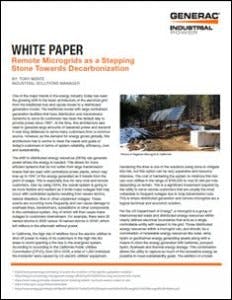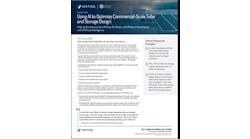A new white paper from Generac explores how remote microgrids can make the overall energy system more flexible and resilient as well as a stepping stone toward decarbonization.
Get the full report.
The electric distribution and transmission system has followed the same hub-and-spoke model for nearly 140 years. But as demand for energy grows around the world, Generac notes that the architecture is now evolving into a more flexible, efficient and sustainable distributed generation model.
In its report, Generac makes the case that distributed energy resources (DERs) and remote microgrids are key to creating a system that’s “more flexible and resilient as it limits mass outages that may occur with centralized systems resulting from severe storms, natural disasters, fires or other unplanned outages.”
The report describes how microgrids powered by renewables can help utilities meet their sustainability goals. Fossil fuel driven generators should be used, according to the paper, to “improve overall system resiliency when the renewable resources are not able to fully meet the load requirements.”
Remote microgrids have a number of benefits for both utilities and their customers, especially when it comes to serving those in remote and rural areas, according to Generac. “The utility can own the microgrid and use it as a DER, providing those remote customers with the same reliability that nonremote customer’s experience. This is likely more consistent reliability than what they were seeing before the microgrid.”
The report also explores how containerized remote microgrids are scalable and can be deployed quickly, saving time and money. It also examines how remote microgrids can reduce energy costs, especially for those living on the grid edge.
“For very remote customers that were relying solely on diesel or propane generation to provide all power needs, by incorporating renewables to form a microgrid, the operating costs of the system will be greatly reduced.” — Generac, Remote Microgrids as a Stepping Stone Towards Decarbonization“
Even businesses can benefit from remote microgrids, according to the Generac paper. Energy costs can be reduced with energy management practices “like peak shaving or participating in demand response programs, as well as provide resiliency during longer utility outages to minimize impact on business operations.”
There is a global push to decarbonization, and remote microgrids will help organizations meet their sustainability goals. This makes them the perfect stepping stone for reducing a company’s carbon footprint while providing an even more resilient power system.
Download the full report, “Remote Microgrids as a Stepping Stone Towards Decarbonization,” to further explore how using microgrids supported by renewables and generators can provide resiliency and help achieve decarbonization goals.








